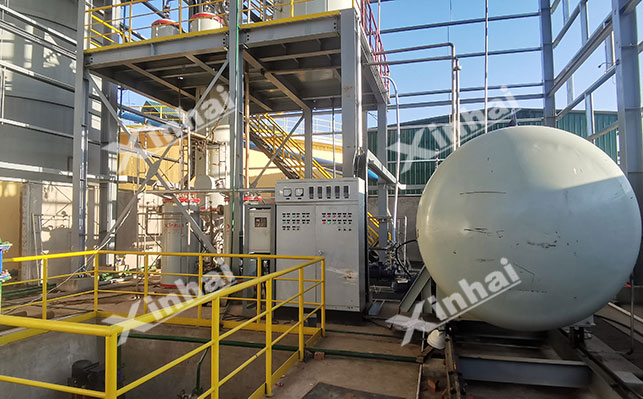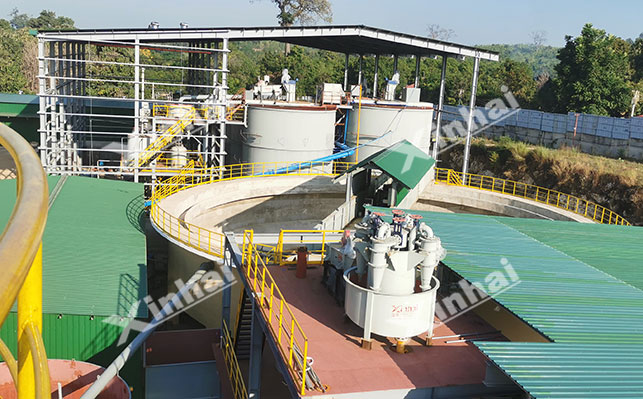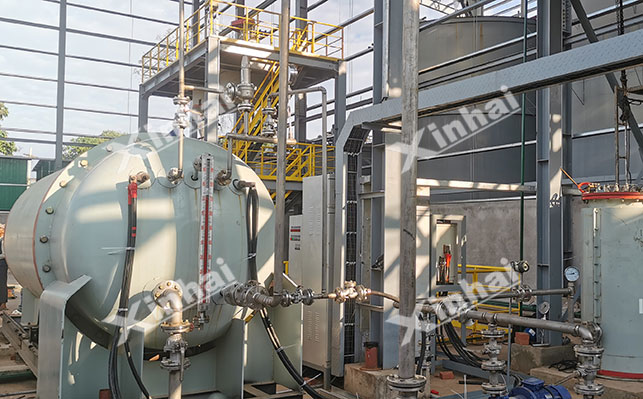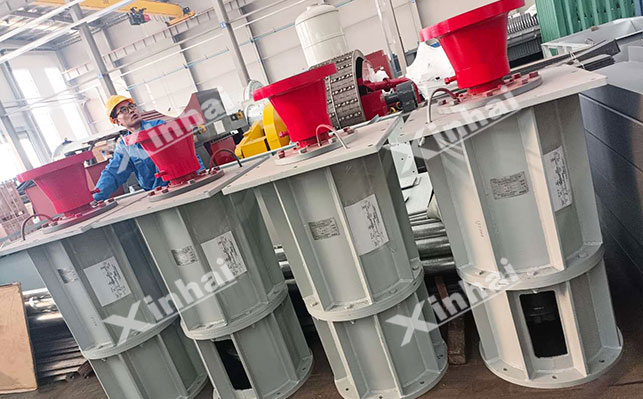
15311826613
Click to add WeChatThe carbon-in-liquid leaching gold process is one of the commonly used methods for gold ore beneficiation. This process is further developed on the basis of the carbon-in-liquid slurry gold extraction process. It combines the two key steps of cyanide leaching and activated carbon adsorption into one, effectively improving the gold selection efficiency and economic benefits.

The carbon-in-liquid leaching gold process mainly utilizes the adsorption characteristics of activated carbon on liquid gold in alkaline cyanide solution. When the gold-containing ore is crushed and ground into slurry, the gold is dissolved from the ore under the action of cyanide leaching agent. At the same time, activated carbon is added to the slurry, and the activated carbon can quickly adsorb the gold-cyanide complex dissolved in the slurry to achieve rapid separation and enrichment of gold from the slurry. This simultaneous leaching and adsorption method greatly improves the dissolution kinetics of gold and promotes the leaching and adsorption process of gold. Compared with the traditional gold extraction process, the carbon-in-liquid leaching process reduces the intermediate links, reduces the risk of gold loss in the process, and improves the overall gold extraction efficiency.
The carbon-in-liquid leaching gold process combines cyanide leaching and activated carbon adsorption. This method can effectively improve the recovery efficiency and economic benefits of gold. The process steps are as follows:
Ore preparation: It is the initial and key link of carbon-in-liquid leaching gold. First, use jaw crushers, cone crushers and other equipment to crush large gold ores in multiple stages to gradually reduce their particle size. Then, the ball mill equipment is used to grind the minerals to -200 mesh, accounting for 85%-90%, so that the gold minerals can fully achieve monomer dissociation.
Debris removal operation: The purpose is to remove impurities and ensure the stable operation of subsequent operations. Usually, linear vibrating screens are used for debris removal at the overflow of the first and second grinding and grading. The first debris removal can also be selected with a spiral screen or a cylindrical screen, and on the premise of ensuring that the screen surface does not run, try to use a small-aperture screen, and add a descaling agent appropriately to reduce scaling on the surface of the activated carbon and the screen, and maintain efficient operation of the equipment.
Pre-leaching concentration operation: Mainly because the product concentration after grinding and classification cannot meet the leaching requirements, it is necessary to concentrate and reduce the concentration index. A concentrator is required to prompt the pulp concentration to about 40%-50% to improve the contact efficiency between cyanide and gold during the leaching process and promote the dissolution of gold.

Stirring leaching and countercurrent carbon adsorption: Multiple sections of leaching tanks are often connected in series. Tank No. 1 is often used as a pre-leaching tank, and the subsequent tanks are leaching adsorption tanks. Each leaching adsorption tank is equipped with a carbon screen to separate activated carbon and slurry. The slurry flows downstream and the activated carbon flows countercurrently. Fresh activated carbon is added from the tail leaching adsorption tank to adsorb the gold in the slurry and is discharged from the No. 1 leaching adsorption tank to become gold-loaded carbon. After the adsorption is completed, the slurry containing gold-loaded carbon is transported to the carbon screen for separation through an air lift, and the gold-loaded carbon enters the desorption and electrowinning operation. After adsorption, the gold grade of the slurry solution can generally be reduced to 0.01-0.03g/m³.
Gold-loaded carbon desorption, electrolytic electrolysis: Gold-loaded carbon and slurry are sent to the carbon separation screen through a carbon pump or air lift, and the screen is rinsed with clean water to separate the carbon and slurry. The gold-loaded carbon enters the carbon storage tank, and the slurry and rinsing water return to the first stage adsorption tank. The desorption of gold-loaded carbon often uses high temperature and high pressure desorption method, such as the Xinhai mining desorption electrolysis system, which only uses sodium hydroxide as the desorption liquid. Under the conditions of 150℃ and 0.5Mpa, about 95% of gold can be desorbed in 6-12 hours. The precious liquid obtained by desorption of gold-loaded carbon is recovered by ionization method. Under the action of direct current, gold ions are reduced to metallic gold by electrons at the cathode and deposited to form gold mud.
Smelting and ingot making: The gold mud obtained by electrolytic deposition is smelted to obtain gold ingots, and hydrometallurgical process is mostly used. By adjusting the smelting temperature and time, and adding fluxes such as borax and sodium carbonate, the melting point of gold is reduced and the smelting efficiency is improved, so that the purity of gold ingots can reach more than 99.99%.
Carbon regeneration: The adsorption performance of activated carbon decreases after desorption, and regeneration treatment is required. First, pickling is performed to remove carbonate and other accumulations. After being returned for use many times, it is sent to the activated carbon regeneration kiln for thermal activation to restore the adsorption activity of the carbon. After cooling in a water quenching tank, the fine carbon separation screen removes fine particles, and it can be recycled to reduce the cost of activated carbon and improve resource utilization.

Chip removal equipment: Linear vibrating screens are mostly used to complete chip removal operations. The eccentric block is driven by a motor to generate high-frequency vibration, so that the slurry flows quickly on the screen surface, and the debris is intercepted on the screen to separate from the slurry. The linear vibrating screen has high screening efficiency, large processing capacity, and stable operation.
Concentration equipment: A high-efficiency concentrator is used. During operation, the transmission device is used to drive the rake frame to rotate slowly, and the slurry deposited at the bottom is scraped to the central discharge port for discharge, and the upper clear liquid overflows through the overflow weir. The high-efficiency concentrator has a high degree of automation, and can automatically adjust the amount of flocculant added and the discharge speed according to the slurry concentration to ensure a stable concentration effect.
Leaching and adsorption equipment: mainly leaching and adsorption tanks and carbon screens. The tanks are equipped with high-efficiency stirring devices to fully mix the slurry and activated carbon and strengthen the leaching and adsorption process of gold. The carbon screen is installed at the outlet of the leaching and adsorption tank to separate the activated carbon and the slurry.
Desorption and electrolysis equipment: mainly desorption columns and electrolytic tanks. The desorption columns are equipped with heating, insulation devices and solution circulation systems, mainly for high-temperature and high-pressure desorption. The electrolytic tank recovers the gold in the precious liquid after desorption by electrolytic method. The cathode and anode are set inside, which can reduce the energy consumption in the electrolytic process and increase the deposition rate and purity of gold.
Activated carbon regeneration equipment: There are rotary kilns, water quenching tanks, fine carbon separation screens, etc. The function of the rotary kiln is to decompose or volatilize the impurities adsorbed on the surface of the activated carbon by high-temperature heating; the water quenching tank is to quickly cool the regenerated activated carbon to prevent it from re-adsorbing impurities at high temperatures; the fine carbon separation screen is used to remove the fine activated carbon particles generated during the regeneration process to ensure that the particle size of the recycled activated carbon is uniform and improve the adsorption effect.

The above is an introduction to the CIL gold extraction method, process and required equipment. CIL gold extraction technology has strong adaptability to gold ore and is suitable for most types of gold ore. It has simple procedures, low investment costs, easy operation and high gold recovery rate. In actual ore dressing plants, a complete carbon leaching process and reasonable equipment configuration are crucial to the effective recovery of gold. Therefore, it is recommended to design a suitable gold extraction plan through ore dressing test analysis to achieve the rationalization of economic benefits, environmental benefits and social benefits.